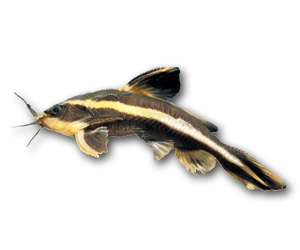Striped Talking Catfish

Quick Stats
| Size | Up to 8.5" (21cm) |
|---|---|
| Tank | 120 litres + |
| Swimming Area | Bottom |
| Ph | 6.2 to 7.6 |
| Temperature | 74ºF to 85ºF (23-29°C) |
| Food | Flakes and Catfish Pellets |
Common Name:
Striped Talking Catfish, Striped Raphael Catfish, Raphael Catfish.
Distribution:
South American lakes and rivers.
Colouration:
Cream or Yellow background with Brown stripes.
Lifespan:
Up to 13 years.
Maintenance:
10% weekly water changes. A nocturnal hunter, the striped raphael catfish typically spends its days in hiding, partially burrowing into any substrate fine enough for it to do so. It will be stressed if no hiding places are provided. This fish is a peaceful, hardy addition to the community tank, territorial only with conspecifics, but should not be kept with any fish small enough to fit in its mouth or they may be eaten. When disturbed, the raphael catfish makes a noise by grinding the bones of its pectoral fins, giving it the common name "talking catfish". Do not catch with a net; the rows of spines on the body and spines on the pectoral and dorsal fins will easily become entangled. Use a jar or other hard-sided container instead. The spines can give a nasty cut, so it is best not to handle this fish.
Feeding:
Fresh algae, zucchini and spinach. Prefers small live foods such as brine shrimp, blood worms, glass worms and tubifex worms. Frozen brine shrimp, plankton, beef heart, glass worms and blood worms. Freeze dried, pellet and tablet food will be accepted on occasion.
Substrate:
Sandy substrate is essential as they like to burrow and also search the substrate with their antennae for food. Larger gravel can damage and even amputate their antennae.
Tank Decor:
The Striped Raphael Catfish, like the Spotted Raphael, likes to burrow in the soft river bottom so provide a corner of fine gravel or sand. They also like some plant cover and hiding places like the hollows of roots. They will not harm plants.
Filtration:
Standard filtration relevant to the tank size.
Biotype:
South American lakes and rivers.
Breeding:
No known way to breed in captivity.